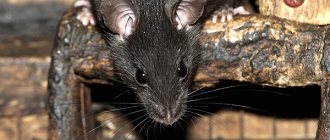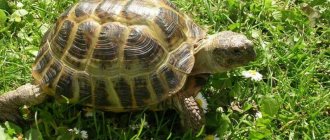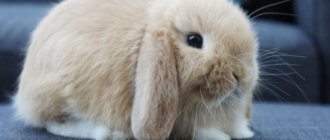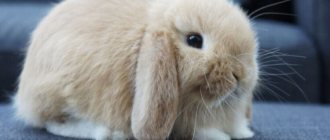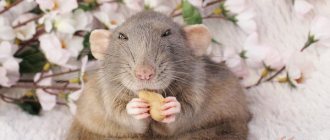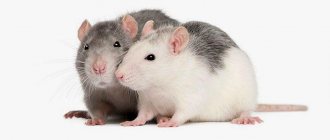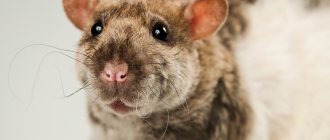Rat teeth are often a cause for concern and a source of myths among rodent lovers. Perhaps this organ, along with the tail, is one of the most amazing in the entire anatomy of the animal. Not only are they incredibly sharp, but they are also capable of developing a pressure of more than 1500 kg per 1 cm2, which makes it easy to chew through lead pipes, cinder blocks and other hard surfaces.
The article discusses in detail what color a rat’s teeth are, how many they should have, structural features, possible problems and ways to solve them.
Features of incisors
The cubs' incisors erupt 1 - 1.5 weeks after birth. A rat's teeth grow very quickly, up to two to three millimeters per week. They grow to normal size after two months, but do not stop growing. This feature is due to the fact that rats chatter their teeth. To avoid breaking, cracking, or dulling, they must be ground off in time.
If the animal does not have the opportunity to do this with the help of a special material, the rodent begins to chatter its teeth. Otherwise, the incisors will begin to bend into a spiral and bend at an angle of eighty degrees. In the wild, this can cause discomfort to the animal, cause hunger, or even lead to the death of the animal. The same applies to individuals with malocclusion. Because of this, they are unable to grind down the lower edge of the enamel correctly.
Rodent dental care
Under natural conditions, pasyuki take care of their teeth on their own. However, decorative rats do not have this opportunity. The owner should help them maintain healthy teeth.
What to give a rat to wear down its teeth
A healthy rat is able to independently grind its incisors on hard objects and food. All that is required from the owner is to organize the constant presence of such items in the cage. Ideal for grinding down rat teeth:
- Mineral stone . Pet stores sell regular and suspended ones. Just before buying, you need to carefully read the composition - there should be no salt in it. As a last resort, you can put regular hard chalk in the cage.
- Small tree branches . You can bring it from your site, or you can buy it. Rodents will most like apple, willow, walnut, and pear. It is worth noting that rats prefer fresh twigs; they lose interest in dry ones.
- Solid treats . For example, grass pads, edible houses for rodents, puffed grains, nuts. For more details, see the article “What treats can you give to rats.”
Experienced rat breeders also recommend placing small wooden blocks or cardboard boxes in the rat cage. Pets will quickly chew them off, grinding down their incisors.
How to trim a rat's teeth
In some situations, decorative rats categorically refuse the treat offered by the owner to grind down their teeth. Then there is nothing left but to trim the pet’s incisors. This should be done as it grows, when the teeth begin to interfere with the fluffy. On average, the interval between prunings is 5 days. The procedure is carried out as follows:
- The rat must be securely restrained so that it does not escape or twist its head. When pruning, there are two people – one holds, the other trims. When trimming yourself, you can swaddle the rat tightly (but not too tightly).
- To avoid sudden closure of the mouth, you will need to insert a regular pencil or an insulin syringe (without a needle) into the diastema.
- It’s not worth cutting your hair right away. At first the rat will struggle and squeak. You need to wait until the animal calms down.
- When the right moment comes, you will need to install nail clippers along the incisors and trim with one click.
- Immediately tilt the animal's head down. This is necessary so that the incisors do not get into the pet’s throat. To be sure, it is recommended to immediately find and throw in the trash the fragments of cut incisors.
The cut should be smooth. There is no need to sharpen the teeth - the rat will sharpen them on its own in the process of gnawing solid food and improvised means. The main thing is not to be afraid or nervous, because the owner’s excitement is transferred to the animal. Rats completely lack nerve endings in their teeth, so the pet will not experience any discomfort (except for mild stress).
If you are unsure and afraid to trim at home, it is better to consult a veterinarian for the first time. The specialist will carry out the procedure in a matter of minutes, and will also give the owner detailed recommendations regarding trimming the pet’s incisors on their own.
The structure of molars
How then does the animal use the molars, and why do they not interfere with the work of the incisors when chewing? Thanks to their wide and flat shape, they are convenient for grinding rather than chewing food. When a rodent absorbs food, its jaw does not move up and down, but one moves slightly back. Therefore, the molars do not knock against each other, but rub.
In baby animals, molars appear in different ways:
- the very first on the nineteenth day after birth;
- on the twenty-first day - the second batch;
- in the fourth to fifth week, the third and last molars appear.
The baby has all the necessary molars and incisors already in the sixth week. The growth of molars continues until the fourth month, and then completely slows down and disappears. The enamel on them is very durable, on the Mohs scale its coefficient is 5.5 (a diamond with a hardness coefficient of 10 is taken as an absolute). Therefore, its abrasion occurs very slowly and has practically no effect on the animal’s life.
Rat Teeth Trimmers
If done correctly, tooth trimming is painless. There are two common methods used to trim incisors. The first is to cut the tooth with regular nail clippers, like you would a toenail. However, this method is not the preferred way to trim teeth. There is a high risk of cracking or chipping the tooth due to the force required to use the clippers. This method can cause pain if the tooth is chipped down to the nerve or cut too short.
The second method is to use a hand-held rotary tool with a cutting wheel to cut off the excess tooth. This method requires a little more skill and anesthesia or sedation for rats since their mouths are very small, but can be easily performed by a trained veterinarian. When using a rotating tool when cutting, there is no injury to the tooth or nerve if it is done correctly. The only concern is injury to the gums or lips if the wheel accidentally hits them or if the tooth is cut too short. This is why rats need to be numbed or sedated in order to have their teeth trimmed properly and safely.
Owners of rats and other exotic pets with ever-growing teeth should be aware of the possible complications associated with their pet's teeth. Without proper attention, overgrown teeth can cause serious injury, anorexia, infection, pain, and even death due to the inability to chew and swallow. Fortunately, the problem of overgrown teeth is easy to solve with regular teeth trimming and checking the length of the teeth.
Mineral composition
A rat tooth consists of three different layers:
- enamels;
- dentin;
- pulp.
The crown is formed by hard enamel, which is located on top. Enamel consists mainly of calcium and other minerals. The softer substance underneath is dentin. It protects the pulp from adverse effects. The soft pulp contains blood vessels and nerve canals. In addition, in the place where it connects to the jaw bone and gum, periodontium is formed, providing reliable attachment both to adjacent molars and incisors, and to the alveolus. In rodents (gophers, mice and others), molars predominantly have a similar structure, while the incisors have minor differences.
Rat face
The muzzle area includes:
- nose;
- eye sockets;
- mouth;
- cheeks;
- chewing area.
The oral slit is located on the anterior and lateral edges of the muzzle. The nostrils are placed at the top of the nose close to each other. A vertical groove begins just below the nose, allowing the upper incisors to be exposed even if the rodent keeps its mouth closed.
There are vibrissae near the tip of the nose. Organs of touch that help the animal navigate and evaluate objects along the way. The eyes are set deep and protected by movable eyelids. Rodents are also characterized by the presence of a third eyelid - a nictitating membrane, and a red glow in the eyes.
How many teeth does a rat have
A specific dental system is a distinctive feature of wild and ornamental rodents.
The total number of teeth is 16, of which 12 are chewing molars and 2 pairs of elongated incisors in the central part of the jaw. There is a significant gap between them and the molars. The purpose of the incisors is to bite. Sharp and strong, they allow the animal to feed not only on grain, but also on insects, as well as smaller animals. Because of this, the wild rat often acts as a predator. Also, the special strength of these pairs of teeth allows rodents to cope with wood, concrete and steel wire.
Rat incisors are constantly growing, so they need regular sharpening. When keeping ornamental animals, it is necessary to provide them with special devices, otherwise the animal may suffer from overgrown teeth. Enamel is present only on the front surface of the incisors. The back is covered with dentin, a softer substance that wears out quickly.
Molars are equipped with cusps or ridges for successful chewing of food. In adults they are erased. The enamel is preserved only on the sides; the middle is also covered with dentin.
Why do rats have yellow teeth?
The incisors of rats are colored with yellow pigment. At first, the pups' teeth are white, but by the twenty-first day, a slight yellowish tint appears on the upper ones. By the twenty-fifth day, they already acquire a distinct yellow color, and the lower ones are just beginning to color. By the thirty-eighth day, the lower incisors become a rich yellow color. But the upper ones are still more intensely colored. This color difference persists throughout the rodent's life. The upper teeth of adult rats are a dark orange-yellow color, while the lower teeth remain yellow.
General characteristics of the animal
Depending on the species, the length of a rat’s body can range from 8 to 30 cm. A distinctive feature is a long tail, sometimes exceeding the length of the body. The weight of the animal ranges from 37-400 g. Particularly large individuals of gray rats can reach a weight of 0.5 kg.
Classic shades of wool are gray and brown, although yellow and orange colors are also found. The main types of wild rats are gray and black, widespread everywhere. The rest of the rodents live in a strictly defined area.
The following breeds are best suited for home keeping:
- standard - large animals with a long tail and smooth fur;
- satin - the animals are covered with a thin six, curling blue;
- Dumbo - funny animals with a wide head, pear-shaped body and large round ears;
- Sphynx - hairless rats with pink shiny fur;
- tailless - a distinctive feature is the complete absence of a tail.
Disease Prevention
To keep your pet healthy and alert, you need to monitor the condition of its teeth and jaws. The appearance of at least one of the following dangerous symptoms should alert the animal owner:
- wounds on the mucous membranes of the lips and cheeks;
- knocking noise that occurs when eating;
- increased secretion of saliva;
- lack of appetite;
- swelling of the mucous membrane or tongue;
- the rat lost a tooth;
- abscess formation.
In this case, you should immediately contact a specialist. The veterinary clinic usually conducts an examination, tests for bacterial microflora, and treats the oral cavity with local antiseptics. If necessary, the doctor can grind or trim the incisors, correct the bite and give all the necessary recommendations for proper care of the pet.
Frequent dental problems
The most common dental problem in rats is, as is known, the constant growth of the incisors, especially if the pet refuses to independently work on grinding them down. Sometimes overgrown teeth grow into the gums or into the skin around the mouth, causing severe pain to the animal. However, rodents also have other dental problems:
- Malocclusion - the animal simply cannot close its mouth normally. In such situations, the pet cannot fully grind down its teeth, so it will have to learn how to trim on its own.
- Abscess - in the presence of small wounds in the oral cavity, suppuration may develop. In advanced cases, it is necessary to remove the tooth along with the abscess.
- A tooth fracture usually indicates an injury to your pet. A rat can break a tooth, for example, when falling from a height or chewing on very hard objects.
- Dental diseases . Decorative rats, like humans, often suffer from oral diseases. For example, caries, stomatitis, periodontitis and many others.
If one of the listed problems occurs, you should contact a ratologist as soon as possible. Perhaps the animal can be helped to completely preserve its dentition.
Rat anatomy: internal structure of organs, skeletal features and fun facts
Rats are amazing animals, if only because their structure is so similar to that of humans that scientific experiments are carried out on them and medications are tested. They belong to the class of mammals (specifically, the order of rodents and the mouse family). In total there are 5 species of 11 subspecies of rats - an amazing variety. These creatures inhabited the entire planet - from wild islands and the foothills of the Alps to large cities. Scientists say that rats do not live except in Antarctica.
On average, these cute creatures live 3 years, and the body weight of an adult varies from 200 to 400 g: females are always smaller than males. Another difference between females is the presence of 6 pairs of nipples: males do not have them at all. They are usually covered with thick hair, but during pregnancy and raising their offspring, this hair falls out.
Diseases of decorative rats and their treatment
Diseases in rats can be divided into two large groups, within which several subgroups are distinguished.
Contagious diseases
They are caused by various biological pathogens (pathogenic microflora, viruses, fungi) and are divided into:
- Infectious diseases of rats;
The causative agents are bacteria, viruses, fungi, rickettsia: listeriosis, ectromelia, salmonellosis, pasteurellosis, infectious pneumonia, tularemia, rabies, tuberculosis, encephalomyelitis.
- Invasive (parasitic diseases).
Caused by infection of the domestic rat's body with ticks, insects, helminths and protozoa: syphaciosis, aspiculuriosis, rodentolepiasis, hymenolepiasis, coccidiosis, demodicosis, pediculosis, fleas, scabies.
Non-communicable diseases
Decorative rats develop as a result of violation of the conditions of feeding and keeping the animal and are divided into:
- Internal;
Diseases of internal organs, blood and metabolic disorders: gastritis, enterocolitis, rhinitis, bronchitis, pneumonia, pyelonephritis, vitamin deficiencies, oncology, allergies, anemia, cardiovascular failure, ischemia, porphyrin.
- External;
Diseases of the limbs, head, neck, skin, tail - wounds, pododermatitis, injuries, skin abscesses, burns, bruises, frostbite, eczema, diseases of the eyes, ears and teeth.
- Diseases of the genital area.
Endometritis, vaginitis, pyometra, miscarriage, spirochetosis.
Treatment of pathologies of ornamental rats is carried out by a veterinarian after determining the diagnosis and determining the cause of the disease; many diseases require specific therapy or euthanasia of the infected animal.
Features and structure of the dental system of rats: complete information
Rat teeth are amazingly sharp and hard. The jaws of a small rodent easily create a pressure of over 1.5 tons per 1 cm². Such jaw power allows the animal to easily bite through lead pipes and steel wire, chew cinder blocks, etc. This article will discuss the characteristics of the teeth of the animal, which is gaining popularity as a pet, as well as the prevention of dental diseases in rodents.
Nutrition and prohibited foods
It is important to know exactly what to feed your dumbo rat. Proper nutrition will help keep your pet active and extend its life.
First of all, you need to carefully ensure that the rat always has clean water. The drink should be changed daily.
The diet of a Dumbo rat should be rich in nutrients and vitamins. It is useful to feed them with grain: oats, wheat, barley. To diversify the diet, you can add boiled liver to animal food: kidneys, liver, heart. Rodents should be given nuts to wear down their teeth.
Dumbo loves fresh apples, peaches, ripe bananas, and cherries. But you need to be careful with dried fruits: they contain a high sugar content.
Knowing what dumbo rats eat, you should exclude the following foods from their diet:
- fatty fried foods
- raw potatoes
- radish, turnip, radish
- cabbage
- artichokes
- legumes
- citrus
- mushrooms
- dairy
- sweets
Many people are interested in the question of whether it is possible to feed a dumbo rat with sausage or meat. The answer is clear: you can’t. Sausages contain a large amount of preservatives, spices and salt, which are dangerous for rodents. The same applies to meats that are high in fat.
Small rodents are fed no more than twice a day, adult Dumbo rats more often: three to four.
How long do dumbos live?
Under good living conditions, the average lifespan of a Dumbo rat is 3-3.5 years. However, premature death of the animal can occur as a result of certain diseases. Representatives of this breed are susceptible to the following diseases:
To avoid adverse consequences for the health and life of your pet, it is important to know the main symptoms indicating malaise: decreased activity, runny eyes and nasal passages, refusal to eat and drink, fur sticking out in different directions, prolonged solitude in a house or in the corner of a cage.
Description of character
Rats are intellectuals with a soul and are very attached to their owner. They need communication and attention, otherwise they will wither away. The character of domestic rats of the Dumbo breed is calmer and more reserved than the rest. They are not that active. Very sociable, freedom-loving and cheerful. Experts advise taking rat pups not from pet stores, but from breeders, when they are very young, then the pets grow up to be affectionate and trusting little animals. Dambiks are very clean. If their house is dirty, they take care of cleaning themselves.
How to tell if a rat is sick
Diseases of domestic rats often arise due to violations of feeding and maintenance standards; hypothermia, overheating or drafts cause colds and inflammatory diseases in smart animals; unbalanced diet and abuse of harmful treats cause obesity, allergies, vitamin deficiencies or intestinal pathologies in pets.
Infectious diseases of rats are also common; domestic rodents can become infected with viral, fungal and parasitic diseases through care items, food or through contact with infected relatives.
Owners of furry rodents often wonder whether a rat can get a virus or a cold from a person. Decorative rats are bred in laboratory conditions, have reduced immunity and are susceptible to human respiratory viral infections. During the acute period of the disease, the owner needs to limit communication with pets, cancel walks and games, leaving only feeding and changing water for the animal.
Diseases of domestic rats can be caused by various causes and pathogens, as a result of which a different clinical picture will be observed. The owner can understand that a pet rat is sick if his beloved rodent exhibits characteristic symptoms common to many pathologies:
- change in appetite or complete refusal of food;
- lethargy, excessive sleepiness, reluctance to play with the owner or other rats;
- changes in the color and odor of urine and feces;
- dirty genitals, the pet stops licking itself;
- dull and tousled coat, formation of bald areas;
- the appearance of causeless aggression, anxiety, nervousness;
- slowness, difficulty moving;
- breathing problems;
- unnatural poses;
- the formation of growths, bumps, swellings on the animal’s body;
- discharge from the nose, eyes, vagina, anus.
Rat paws
The rat's front legs include:
- armpits;
- shoulder;
- elbow;
- forearm;
- brush.
The hind legs of a rat are divided into:
- hip;
- shin;
- heel area;
- tarsal area;
- metatarsus
Pros and Cons of Keeping Dumbo as a Pet
The decorative rat is one of those pets that does not require large expenses for its maintenance. Rats are curious and everyone wants to try their teeth. In addition, they require constant attention as they can fall and get hurt.
What attracts these animals is their developed intellectual abilities and lack of aggression towards humans and other animals.
The advantages of choosing Dumbo the rat as a pet include:
- cleanliness of the animal;
- omnivorous;
- low maintenance costs;
- ease of care.
But there are also disadvantages:
- the property of an animal to leave marks wherever it is;
- tendency to chew on any objects;
- expensive treatment;
- people with a keen sense of smell notice a specific smell that comes from domestic rats;
- for your pet to feel well, you need to devote a lot of time to it;
- walking is required;
- relatively short lifespan.
Rat anatomy: location of internal organs
Since, as we have already said, rats belong to the category of mammals, the arrangement of their organs is not much different from their relatives in biological species. In the picture below you can see all the organs in cross-section:
1 - aorta; 2 - heart; 3 - light; 4 - diaphragm; 5 - spleen; 6 - ovary; 7 - kidney; 8 - oviduct; 9 - bladder; 10 - cecum; 11 - pancreas; 12 - stomach; 13 - liver.
And here is a detailed diagram of the circulatory system of a rat:
1 - atria; 2 - ventricles; 3 - left aortic arch; 4 - innominate artery; 5 - left subclavian artery; 6 - right subclavian artery; 7 - carotid arteries; 8 - dorsal aorta; 9 - splanchnic artery; 10 - anterior mesenteric artery; 11 - renal artery; 12 - posterior mesenteric artery; 13 - genital artery; 14 - iliac artery; 15 - caudal artery; 16 - anterior vena cava; 17 - jugular veins; 18 - subclavian veins; 19 - tail vein; 20 - iliac vein; 21 - mesenteric vein; 22 - portal system of the liver; 23 - hepatic vein; 24 - posterior vena cava; 25 - pulmonary artery; 26 - pulmonary vein; 27 - azygos vein.
Rat body temperature
Normally, the body temperature of a decorative rat is 38.5-39.5 degrees. A slight increase may suggest stress, heat stroke, or the initial stages of an infection. A temperature of 40.5 degrees is a signal to urgently go to the clinic, but it must be brought down immediately. This is done by using ice packs or rubbing small pieces of ice on the ears.
A drop in temperature is much more dangerous and indicates an advanced infectious disease or shock. In this case, it is necessary to lift it with heating pads, and then immediately take the pet to the veterinarian.

